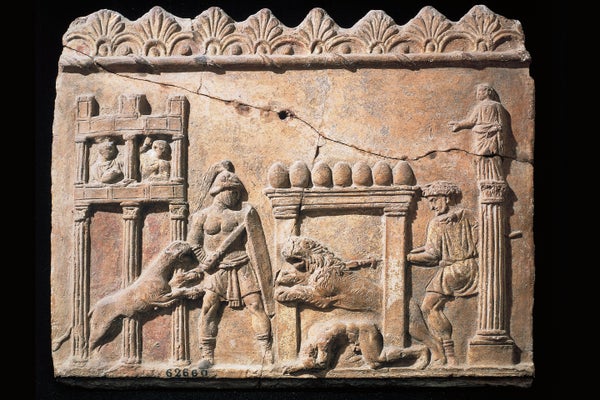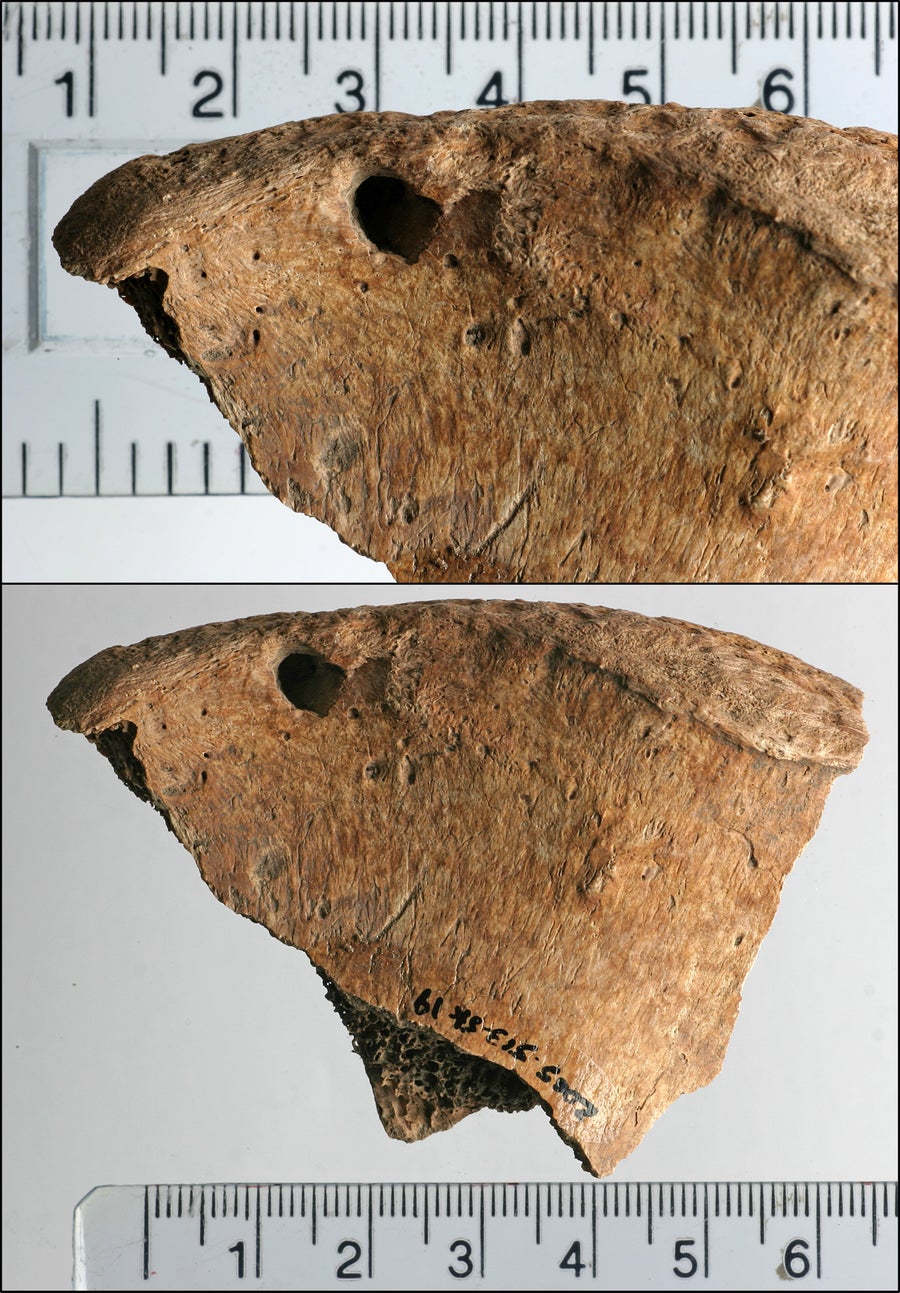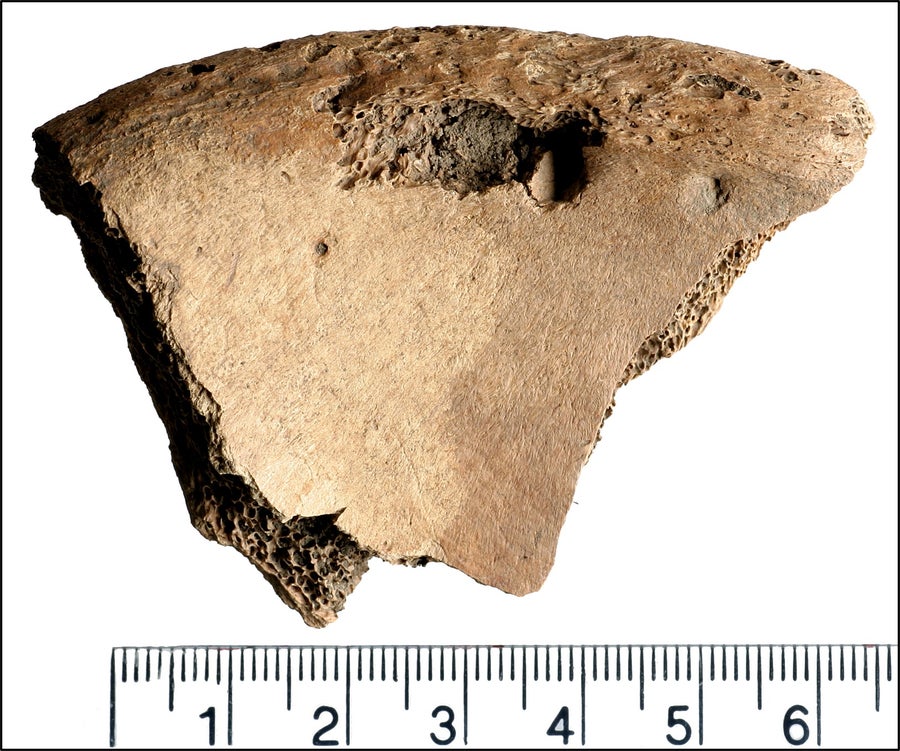Lion Chew to the Butt Could Be First Proof of Human-Animal Gladiatorial Fight
The primary bodily proof of Roman gladiators combating animals has been present in skeletal stays from England

1st century AD Roman aid portraying gladiators and lions combating.
DEA/A. DAGLI ORTI/De Agostini by way of Getty Photos
Roman gladiators’ fights to the demise have impressed morbid fascination for millennia. However for one thing seemingly so well-documented, it’s uncommon for archaeologists discover bodily proof of such fight within the type of Roman gladiators’ stays. Most of what we all know in regards to the fights comes from oblique information, similar to texts or illustrations that described the bloody, raucous occasions. Amongst such information, some depicted so-called beast hunts, wherein gladiators have been pitted towards predators that included lions, tigers and even elephants.
Now archaeologists have discovered the primary bodily proof of a gladiator locked in fight with one in all these animals—which seems to have left an enormous, lion-sized chew mark on the fighter’s butt. The findings have been revealed on Wednesday in PLOS One.
Tim Thompson, a forensic anthropologist at Maynooth College in Eire, spends a whole lot of time inspecting the disfigured skeletons of people that died way back. Round 2017 he was finding out human stays uncovered throughout a 2004 excavation of Driffield Terrace—a web site in York, England, that proof suggests was a gladiator burial floor through the Roman Empire. Thompson and his colleagues have been rapidly drawn to a skeleton that sported a weirdly formed chew marks on its pelvis.
On supporting science journalism
If you happen to’re having fun with this text, take into account supporting our award-winning journalism by subscribing. By buying a subscription you’re serving to to make sure the way forward for impactful tales in regards to the discoveries and concepts shaping our world right this moment.

Lesion on the proper ilium of 6DT19.
“Distinctive osteological proof for human-animal gladiatorial fight in Roman Britain,” Thompson TJU, Errickson D, McDonnell C, Holst M, Caffell A, Pearce J, et al., in PLoS ONE, Vol. 20, No. 4, Article No. e0319847, Printed on-line April 23, 2025

Lesions on the left iliac backbone of 6DT19
“Distinctive osteological proof for human-animal gladiatorial fight in Roman Britain,” Thompson TJU, Errickson D, McDonnell C, Holst M, Caffell A, Pearce J, et al., in PLoS ONE, Vol. 20, No. 4, Article No. e0319847, Printed on-line April 23, 2025
When the bones have been first unearthed, archaeologists wouldn’t have had the know-how to probe the intriguing marks a lot additional. Thompson and his workforce wished to know what prompted them—and now had the laboratory strategies to seek out out. They collaborated with zoos to create three-dimensional scans of chew marks on leftover carcasses that have been made by kinds of animals, similar to lions and cheetahs, that had been utilized in Roman gladiatorial reveals.
In addition they chemically analyzed the traditional Roman bones to verify different traits, such because the deceased individual’s intercourse and dietary situation—clues that might assist decide whether or not this skeleton may actually have come from a Roman Empire–period gladiator. The researchers say they have been additionally in a position to estimate that the damage’s timing was roughly concurrent with that of the fighter’s demise.
The workforce in contrast the scans of the trendy carnivore bites to these on the traditional bones. The seemingly perpetrator of the latter: a lion. Marble artifacts from Roman Britain depict lions mauling gladiators, Thompson says, however no confirmed archaeological proof had been discovered. Some specialists have additionally speculated that if this human-animal fight certainly occurred, it solely occurred in Rome—not within the far-flung edges of the empire. “The idea has all the time been that perhaps that [artifacts from Roman Britain] are simply reflections of issues taking place in Rome, virtually tapping into Roman fantasy,” Thompson says. “What we’re suggesting now, really, is that we’ve got proof for that spectacle taking place [here in York].”

Lesion on the left iliac backbone of 6DT19.
“Distinctive osteological proof for human-animal gladiatorial fight in Roman Britain,” Thompson TJU, Errickson D, McDonnell C, Holst M, Caffell A, Pearce J, et al., in PLoS ONE, Vol. 20, No. 4, Article No. e0319847, Printed on-line April 23, 2025
The brand new discovering not solely presents fascinating clues into the tradition of gladiatorial fight but in addition highlights the astonishingly far-reaching affect of the Roman Empire. “This was one of many key ways in which Roman tradition was unfold—a spectacle,” says Anna Osterholtz, a bioarchaeologist at Mississippi State College, who was not concerned within the new examine. “Since you would even have executions that may be happening as a part of the video games, it taught issues like social roles and social norms.”
Kathryn Marklein, a organic anthropologist on the College of Louisville, who was additionally not concerned within the examine, factors to the exorbitant value these fights would have incurred. Lions aren’t native to England, so it might have required appreciable expense and energy to deliver the animals all the best way to York. “Placing this amount of sources into an occasion is a testomony to the significance of violent spectacles in Roman provinces,” Marklein says.
Skeletal stays can reveal a terrific deal about items of human historical past that may in any other case be misplaced to time. “Our lives are inscribed into our bones,” Osterholtz says. These stays can inform us about “individuals’s lives that weren’t thought-about vital sufficient to be written down, that have been by no means a part of the official document.”


